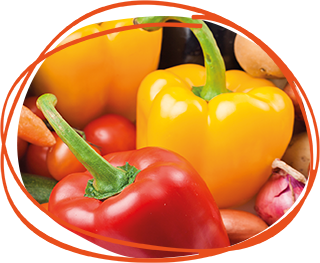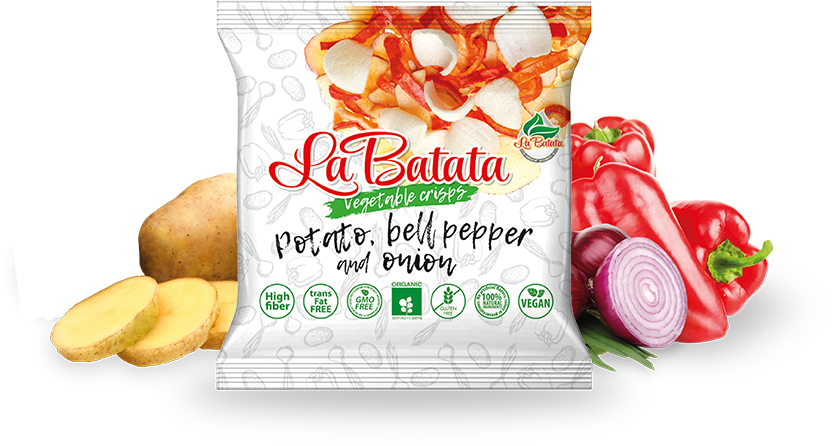
INGREDIENTS
Vegetable crisps contain only natural ingredients, without fragrances, preservatives, intensifiers of taste. Production does not contain GMO, gluten and palm oil. The product is GMO, gluten and palm oil free.
The innovative production technology keeps useful substances, vitamins and excellent taste of vegetables.
The great part of the vegetables and fruits is grown on the private fields of the company in a pristine area in the South of Russia. Nutrition and energy value
Storage conditions: store in dry places at a temperature of +5°C to +25°C.
After opening, store at a temperature of 15°C to 25°C and relative humidity of 40%
to 60% for maximum 24 hours.
 By vitamin C content sweet pepper occupies a leading place among the vegetables. Bell peppers also contain vitamin P, vitamin A, B, carotene, folic acid, as well as calcium, potassium, iron, phosphorus, copper, iodine, magnesium, sodium and zinc. Bell pepper is a source of beneficial vitamins, that help to rejuvenate and strengthen the body. Antioxidants, which are part of the bell pepper, rejuvenate the cells, thin the blood, and also remove cholesterol. Pepper increases hemoglobin in our blood. As well, bell pepper contains lycopene, which prevents cancer. Regular consumption of bell pepper improves skin condition, visual acuity, and enhances hair growth. Scientists strongly recommend fighting depressive conditions and insomnia with the help of bell peppers.
By vitamin C content sweet pepper occupies a leading place among the vegetables. Bell peppers also contain vitamin P, vitamin A, B, carotene, folic acid, as well as calcium, potassium, iron, phosphorus, copper, iodine, magnesium, sodium and zinc. Bell pepper is a source of beneficial vitamins, that help to rejuvenate and strengthen the body. Antioxidants, which are part of the bell pepper, rejuvenate the cells, thin the blood, and also remove cholesterol. Pepper increases hemoglobin in our blood. As well, bell pepper contains lycopene, which prevents cancer. Regular consumption of bell pepper improves skin condition, visual acuity, and enhances hair growth. Scientists strongly recommend fighting depressive conditions and insomnia with the help of bell peppers.
fresh potatoes
fresh bell pappers
fresh onions
vegetable oil
starch syrup
common edible salt
Expiry date is 6 months
fresh bell pappers
fresh onions
vegetable oil
starch syrup
common edible salt
The great part of the vegetables and fruits is grown on the private fields of the company in a pristine area in the South of Russia. Nutrition and energy value
| Nutrition facts, Calories, average values (per 100g of the product) |
Gramme |
| Proteins | 4,5 |
| Fats | 21 |
| Carbohydrates | 52 |
| kcal | 420 |
| kJ | 1740 |
 By vitamin C content sweet pepper occupies a leading place among the vegetables. Bell peppers also contain vitamin P, vitamin A, B, carotene, folic acid, as well as calcium, potassium, iron, phosphorus, copper, iodine, magnesium, sodium and zinc. Bell pepper is a source of beneficial vitamins, that help to rejuvenate and strengthen the body. Antioxidants, which are part of the bell pepper, rejuvenate the cells, thin the blood, and also remove cholesterol. Pepper increases hemoglobin in our blood. As well, bell pepper contains lycopene, which prevents cancer. Regular consumption of bell pepper improves skin condition, visual acuity, and enhances hair growth. Scientists strongly recommend fighting depressive conditions and insomnia with the help of bell peppers.
By vitamin C content sweet pepper occupies a leading place among the vegetables. Bell peppers also contain vitamin P, vitamin A, B, carotene, folic acid, as well as calcium, potassium, iron, phosphorus, copper, iodine, magnesium, sodium and zinc. Bell pepper is a source of beneficial vitamins, that help to rejuvenate and strengthen the body. Antioxidants, which are part of the bell pepper, rejuvenate the cells, thin the blood, and also remove cholesterol. Pepper increases hemoglobin in our blood. As well, bell pepper contains lycopene, which prevents cancer. Regular consumption of bell pepper improves skin condition, visual acuity, and enhances hair growth. Scientists strongly recommend fighting depressive conditions and insomnia with the help of bell peppers.
Net weight:




Bell peppers and a host of pepper cousins are some of the most versatile vegetables in the kitchen, no matter where you go in the world. It's interesting that in Russia they call it "Bulgarian" pepper, although its real homeland is America. Bell pepper was brought to Russia from Turkey and Iran in the 16th century. It began to be cultivated on an industrial scale in the 19th century.
